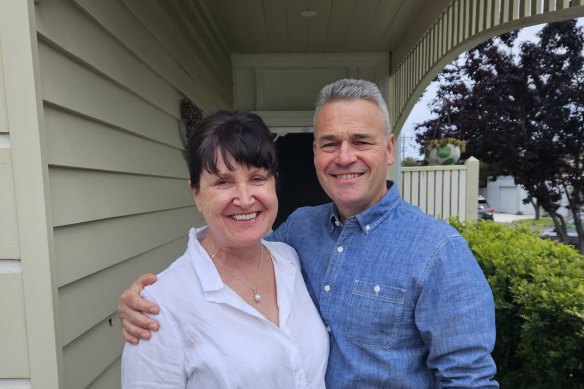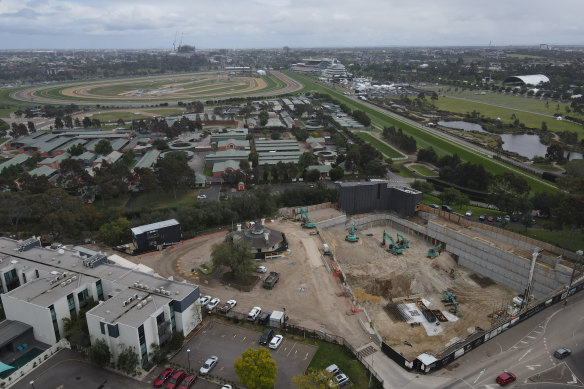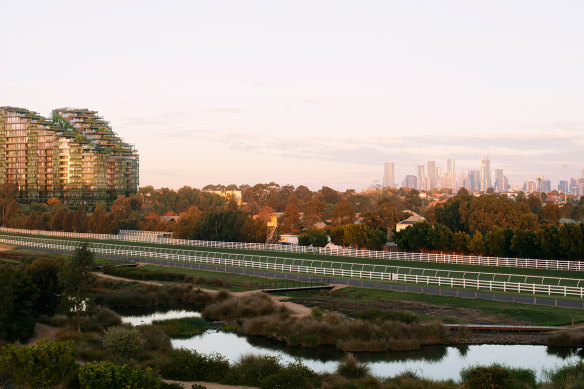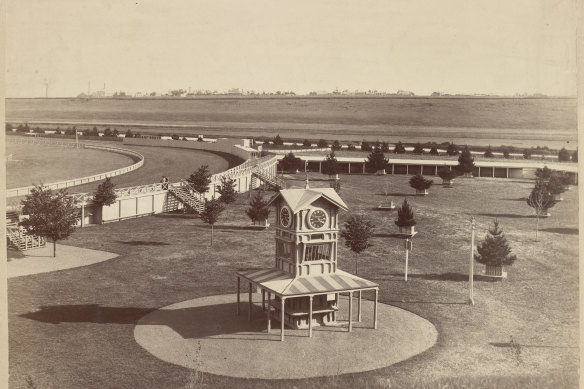
Save articles for later
Add articles to your saved list and come back to them any time.
In two years, 58-year-old Michael Spelic will be able to sip a morning coffee on his balcony and watch racehorses train.
Located at Flemington Racecourse, his new apartment is part of the 183-year-old racecourse’s first-ever housing development.
Michael and Susan Spelic at their Williamstown home.
“I’d call myself a moderate racing fan,” said the builder, who will be downsizing with his partner from their three-bedroom home in Williamstown to a luxury terrace apartment in The Darley development.
“We’ll be able to see the bay, see the north-west suburbs of Melbourne, watch the storms rolling in and all the activity at the racetrack is quite exciting to watch,” Spelic said.
As crowds flock to Flemington this week for the start of the Melbourne Cup Carnival, there are growing calls to normalise the idea of living at the city’s racetracks – some of the largest open spaces left in inner and middle Melbourne, and close to existing infrastructure.
In 2017, then planning minister Richard Wynne rezoned two parcels of surplus land at Flemington Racecourse for housing developments.
The Darley apartment complex under construction at Flemington Racecourse.Credit: Eddie Jim
One site was at Epsom Road on the east boundary of the racecourse site, and the other, called the Flemington Green, located on the north-west boundary near Flemington Racecourse train station.
Four years earlier, the Victorian Racing Club and Chinese-developer Greenland had proposed three buildings ranging from 14 to 25 storeys at the Flemington Green site, and one tower of 31 storeys at the Epsom Road site.
What was ultimately approved in 2017 was a much scaled-back version: at Epsom Road a single tower of no more than 15 storeys and 300 units, while the three towers at Flemington Green could be no more than 10 storeys and a maximum of 520 units in total.
Pace Developments Group acquired the 10,600 square metre Epsom Road site for its Darley development from the Victoria Racing Club after a sale to Greenland in 2013 fell over.
The Darley development – which is now 60 per cent sold off the plan – is now underway, with the site being excavated and due for completion in 2025. But there has been no movement at all on the Flemington Green site off Leonard Crescent.
Des Grogan, a now-retired traffic engineer and town planner who sat on the planning panel that scrutinised the rezoning proposal for the former planning minister, said he believed the key to unlocking the area for future housing was activating the Showgrounds train line, which only runs a handful of days a year for special events.
The Victorian Racing Club, locals and the planning panel were all supportive of activating the train line to become a daily commuter service to the city, according to Grogan, but the state government under then premier Daniel Andrews outright rejected the idea.
Grogan said residents were told that Showgrounds and Flemington Racecourse stations could not be used for commuter services for two reasons: “One, the signalling at North Melbourne station is such that a regular service would impact the Craigieburn line, and the second, that they would have to buy new trains.”
He argued that six years on, the government’s position should be revisited. “There’s no justification for not upgrading the signals and buying new trains compared to the money being spent on the SRL [Suburban Rail Loop].”
A spokesperson for Victorian government said the area was already well served by trams and the nearby Newmarket train station, and that impacts to the Craigieburn line would affect “some of Melbourne’s fastest-growing communities”.
Flemington is not the only Australian racecourse opting to develop parcels of land – some with the explicit intention to secure their financial futures in the face of dwindling race attendance.
Mega-developer Mirvac started a housing development on the Eagle Farm Racecourse in Brisbane last year, while the South Australian Jockey Club is redeveloping part of the Morphettville Racecourse in Adelaide with 400 homes.
An artist’s impression of the new luxury development The Darley at Flemington Racecourse.
The Moonee Valley Racing Club this year won approval for a plan to redevelop racecourse land, with the entire centre field of the track to be reconfigured to include a recreation zone for locals on non-race days and housing on the eastern perimeter of the track.
Meanwhile, a fierce battle is underway over the future of Sandown racecourse in Melbourne’s south-east, which could shut down the entire racecourse for residential development.
Town planner Colleen Peterson, CEO of Ratio Consultants, said that like golf courses, the utility of racetracks for the wider public were now being scrutinised in the face of a housing crisis and need for accessible green spaces.
The state government recently announced an ambition to build 80,000 homes a year for the next 10 years – more than double the rate of current home builds.
Flemington Racecourse in 1880.Credit: State Library of Victoria
“I think we need some more radical changes to the system and tapping into underutilised land, whether it’s owned by golf courses and racing tracks, whether it’s VicTrack land, or land owned by water authorities,” said Peterson.
Peterson said that putting housing on surplus land at racetracks “makes good sense”.
“Obviously, we need to make sure that the form of development that takes place is appropriate within its broader context,” she said.
“But by virtue of being in the middle of or next to a racecourse, you’re a pretty long way away from any immediately sensitive areas, and the classic planning issues like overshadowing and overlooking are pretty much taken care of.”
Peterson also pointed to research from Infrastructure Victoria which estimates the cost of providing homes in greenfield areas on Melbourne’s fringes can cost up to four times as much as homes in areas near existing public transport and infrastructure.
“It’s part of the reason [racecourses] are so successful is they can get people in and out on race days without people needing to use cars,” she said.
The Victorian Racing Club said in a statement that while there were no immediate plans to develop the Flemington Green site, the club was working on a “2040 Master Plan” that would “frame the next generation of the Flemington precinct and other associated assets”.
The state government pointed to its nearby new builds on public land at Victoria Street, which is almost complete. It will provide 240 new social homes and 119 private affordable homes on the same site where four high-rise public housing towers have been earmarked for demolition to be redeveloped.
“We are forging ahead with the redevelopment of the Flemington Housing precinct as part of our Big Housing Build, which is set to deliver new social and affordable housing just five kilometres from Melbourne’s CBD and close to the services Victorians need,” a spokesperson said.
Get the day’s breaking news, entertainment ideas and a long read to enjoy. Sign up to receive our Evening Edition newsletter here.
Most Viewed in National
From our partners
Source: Read Full Article



